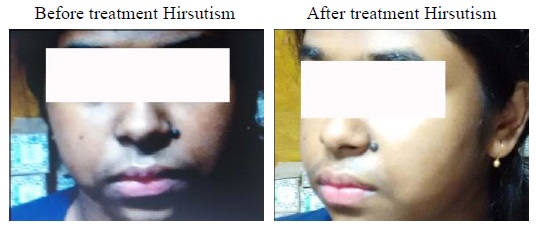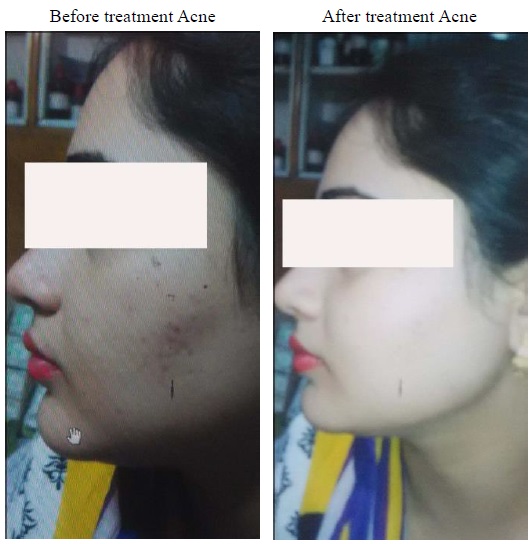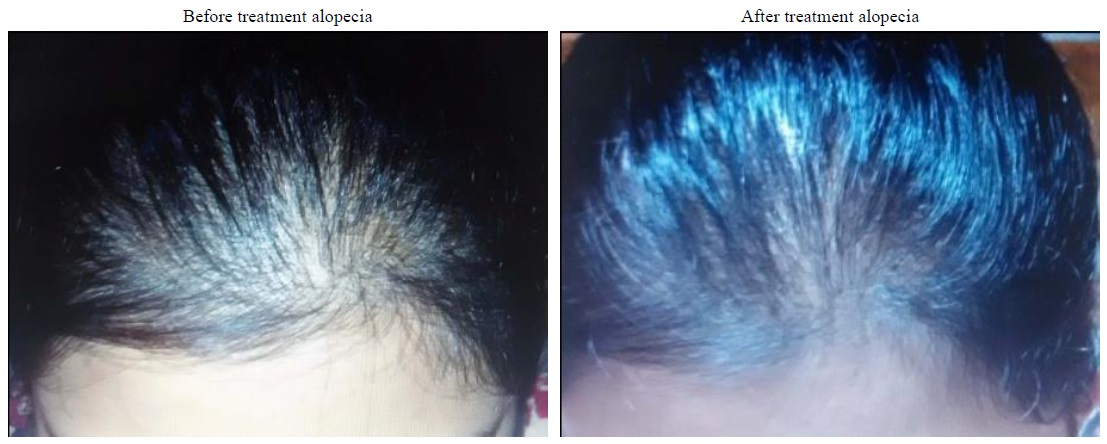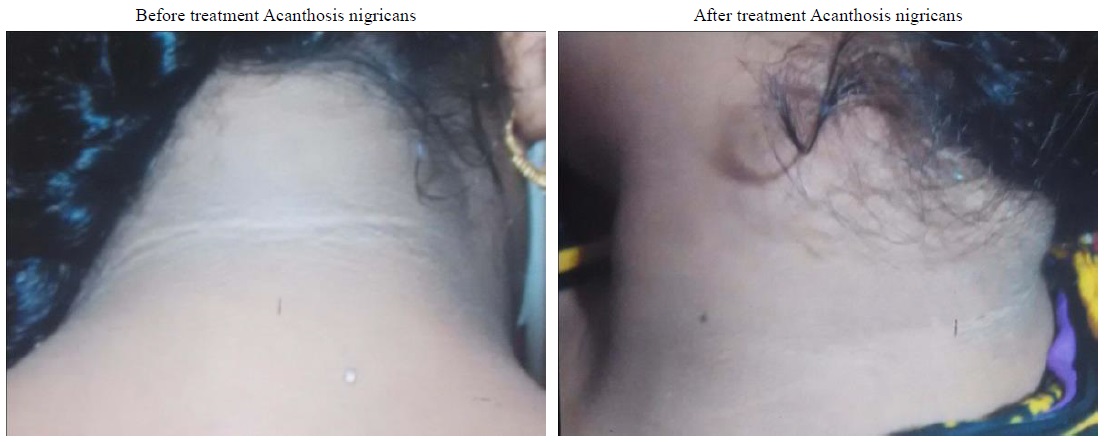



In continuation of our systematic study on the occurrence of Poly Cystic Ovary Syndrome (PCOS) and the healing effect of two frequently used homoeopathic medicines Calcarea carbonica (Calc) and Lycopodiam clavatum ( Lyco) (Das et al., 2015), as revealed from observation of some external parameters of study like regularity/irregularity of menstrual cycle, presence/absence of acne, hirsutism, male type alopecia, acanthosis nigricans, body/mass index (BMI) and waist-hip ratio, this study aims at reporting the favourable modulating effect, if any, of these drugs on certain hormones like follicle stimulating hormone (FSH), luteinizing hormone (LH), estradiol (E2), testosterone (Free/Total), dehydroepiandosterone (DHEA-S), prolactine, progesterone (17-Hydroxyprogesterone), and TSH including T3, T4, and Insulin. The associated changes in fasting glucose levels, if any, in the patients were also studied. These hormones are known to be playing some kind of role in irregular menstrual cycle and PCOS. In fact, according to Rotterdam criteria (Revised 2003 consensus), cysts in either or both ovaries (as determined by ultrasonography and other diagnostic criteria) can qualify to be designated as those belonging to PCOS if at least two other features like irregular menstrual cycle, and some abnormality or deviations are also encountered in certain relevant hormonal parameters. Thus, the parameters for diagnosing PCOS considered in this study basically comprised of two of the following three criteria: oligo- and/or anovulation, clinical and/or biochemical hyperandrogenism, and polycystic ovaries upon ultrasound detection.
As far as the authors are aware, no systematic study on these parameters had been conducted earlier in India with the intervention of the homeopathic drugs, Calc and Lyco, frequently used in symptoms indicative of PCOS including irregularity in menstrual cycle and hormonal deviation from the respective normal levels, although the accepted protocols for the study of PCOS have been suggested (CCRH, 2014), but the actual research data still awaited.
Therefore, in this study, we tested hormonal levels of suspected PCOS patients undergoing homeopathic treatment with either of these homeopathic remedies, Calc (n = 20) and Lyco (n = 20) at four fixation intervals starting at 0, 6 months, 12 months and 18 months, retaining a few placebo treated subjects (n = 5) as control, with a view to scrutinizing if either drug had any differential effect on any specific parameter.
Thus the hypotheses to be tested in this study were:
1. If Calc and Lyco could modify favourably any/all of the guiding hormonal attributes like FSH, LH, estradiol (E2), testosterone (Free), DHEA-S, prolactine, progesterone (17-Hydroxyprogesterone) where anovulation is suspected from other indications, TSH (and T3 and T4 in case of history of thyroid abnormality), and Insulin (PP/Fasting) in a time-dependent manner; additionally, fasting glucose levels were also estimated for possible correlation.
2. To analyse the relative efficacy of the drug in respect of each of these hormones by comparing data analysis of the patients either taking Calc or Lyco, so that emerging data could be utilized in a strategic way in the control and management of PCOS more effectively.
The details of the subjects and collection of phenotypic data have only been mentioned in brief here as these have already been provided in our previous paper (Das et al., 2015). In brief altogether 40 (n = 40) women of reproductive age served as the subjects of this study apart from five patients who received placebo only and served as controls. All subjects signed informed consent, and agreed that research data connected with this study can be published. The subjects who were to receive “verum” were divided into two groups of 20 each; each sub-group received either Calc (n = 20) or Lyco (n = 20) as their remedies; these patients were the same as those who received Calc and Lyco belonging to the same group as reported earlier (Das et al., 2015) as both the studies were concurrently conducted.
Twenty patients were administered Calc 30 C twice a day for seven consecutive days and the other twenty Lyco 30 C were also administered in the same manner. The respective drugs were then withdrawn for 7 days in both groups of patients for seven days and the drugs were again administered and then again withdrawn in the same way till the desired amelioration was observed, because our primary objective was to remove the cysts and/or other manifestations of PCOS; in homeopathy practice, after the selected drug shows initial response but fails to show further improvement, it is unequivocally recommended that the higher potency be administered. Again, by following the homeopathic principle of period of use of specific remedies, after obtaining positive amelioration effect in respect of menstrual cycle, the period of drug treatment was increasingly reduced till substantial amelioration in terms of positive recovery of the parameters concerned were observed. In only a few cases, the higher potency of 200 C had to be given to patients where no further improvement could be observed even after repeated doses of 30 C administration for a reasonable period. In that case, the 200 C potency was given once daily for four days and a gap of seven days was maintained before the next dose was administered. The drugs and potencies were selected generally on the basis of holistic approach of guiding symptoms as recommended in Materia Medica and Organon (Allen, 1996; Boericke, 2002; Kent, 1985). Diagnostic guiding symptoms induced by each medicine were carefully noted at certain fixed time-points and finally drugs were withdrawn when ultrasonic results confirmed total/partial removal of cysts or palpable reduction in their size/number along with the reduction of the volume of ovary/ovaries. Whether or not the PCOS patients showed amelioration/cure in respect of all the guiding symptoms, the experiment was terminated at 18 months of fixation.
>
Selection of potency of drugs
In this study, mainly the 30th potency was used till the positive changes in the recovery process continued, after which the patients were generally administered the 200th potency if and when needed, as per the standard homeopathic practice (Hahnemann and Künzli, 1982); for this reason, the introduction of the 200th potency could not be done and varied from patient to patient; but we followed this change of potency rule uniformly and strictly depending on the condition and symptoms of the patients, as also conventionally followed by most other physicians (Close, 2003).
>
Method of preparation of potencies
The method of preparation at the centesimal scale is based on the principle that 1 ml of the mother tincture (1%) be added with 99 ml of ethanol (generally 70 - 95% by different manufacturers) and given 10 equal mechanical jerks (or succussions) to get potency 1. Similarly 1 ml of the 1 C potency is added with 99 ml of ethanol and again given 10 jerks to produce the potency 2 and so on (Das et al., 2016).
Calc and Lyco have been procured from Hahnemann Publishing Co. (Hapco), 165, BB Ganguly Street, Kolkata-700012. The homoeopathic medicines used in this study were prepared by following the HPI (Homoeopthic Pharmacopia of India) from the mother tinctures by the standard method of succussion and dilutions using 70% ethanol as the “vehicle”.
>
Choice of parameters of study
We have considered mainly those hormones in this part of our study which have been implicated to play a role in inducing PCOS. We also considered glucose level as diabetes is sometimes more commonly found in PCOS patients, presumably for which Metformin is routinely prescribed for PCOS patients by practitioners of orthodox medicines. Similarly, for the same reason, free testosterone, insulin and glucose have also been considered for analyzing their role, if any, in PCOS patients.
>
Methods adopted for different hormonal assays
Standard methods as routinely followed by most pathological laboratories in regard to analysis of data pertaining to different hormonal tests have been followed in the present study. In brief the standard ELISA (Van Weemen and Schuurs, 1971) or CLIA method (Woodhead and Weeks, 1985) was adopted for recording data of all hormones studied.
The study protocols and guidelines were duly approved by the Institutional Ethical Committee (Vide -No. The (IEC) certificate ref no – 212/MBHCH/C/RES/01/11 dated. 4/7/2011).
The data were analyzed by statistical means by adopting the ANOVA and “paired t-test” methods, wherever applicable, to determine the level of significance between the changes in parameters of study before and after treatment of the respective drugs at different time-points. The statistically significant differences have been marked by the sign # in case of ANOVA (SPSS-20) and by asterisk (*) mark in case of paired “t” tests in the table in respect of the different study parameters.
To see if the ratio of LH/FSH has any diagnostic value in ascertaining/confirming the presence of PCOS (Table 1), we categorized our data into four distinct groups: namely i) those showing the ratio above 3; ii) those showing the ratio below 3 but above 2; iii) those showing values between 1 and 2, and iv) those showing the values below 1. Analysis of the data on these categories revealed that 4 out of 40 patients diagnosed with PCOS had the ratio above 3 (statistically non-significant = ns), 24 showed the ratio between and 2 and 3, 12 had the ratio between 1 and 2 (significant = *), and none had a ratio below 1. Therefore, from these data, it could be seen that patients with PCOS had a tendency of having the ratio between 2 and 3, followed by those of the next value between 1 and 2 by 12 patients. The other two groups, that is, having ratio of above 3 and below 1 represented by strikingly less number of patients. Thus, there was an indication that the patients showing more surge of LH in relation to FSH will be most likely to have confirmed PCOS, consistent with results of some earlier workers (Banaszewska et al., 2003).
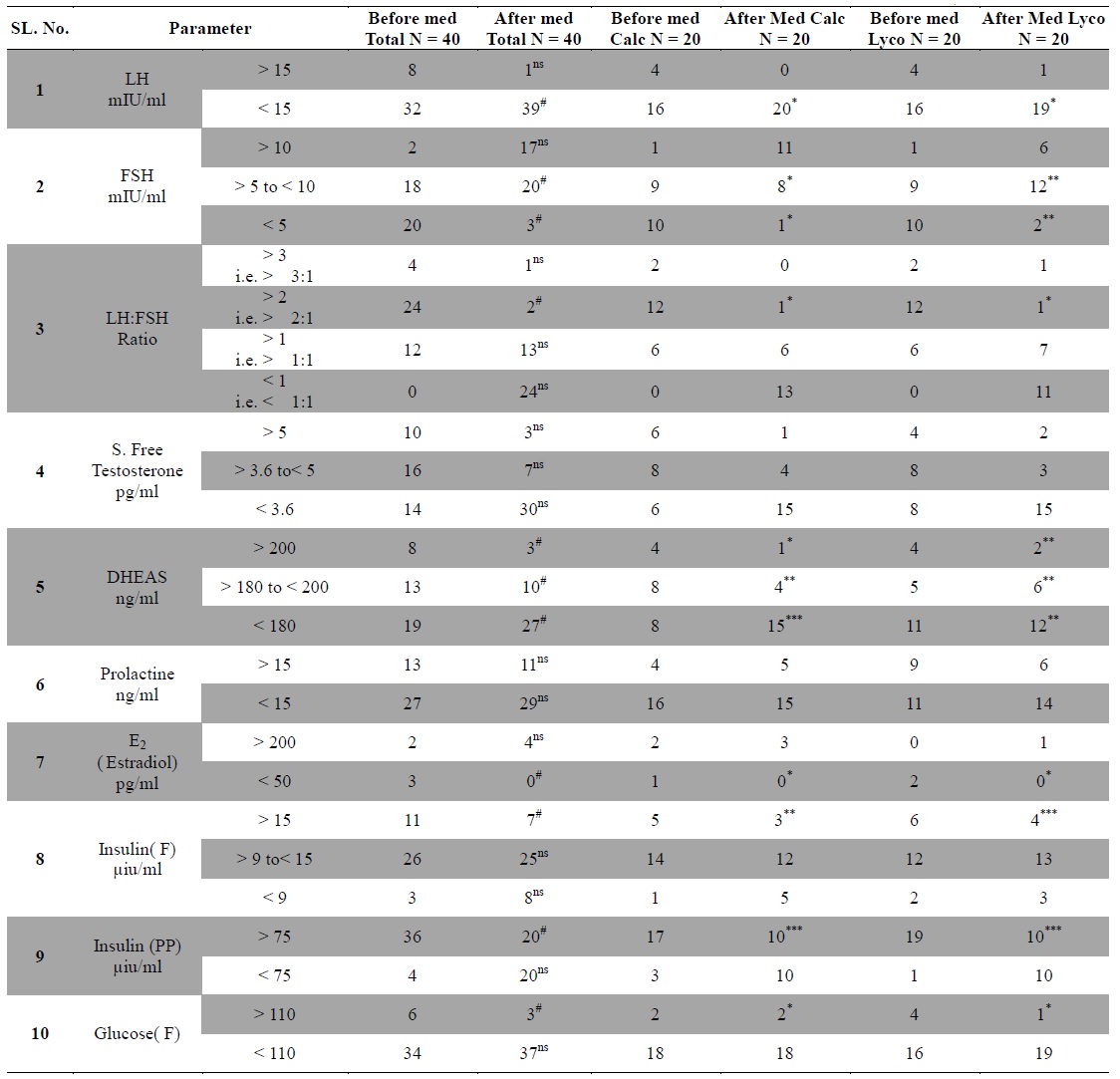
Showing data of Blood parameters recorded before and after administration of drugs in all patients (total N=40) receiving “ verum”
The results of the free testosterone apparently had low or little diagnostic value as none of the differences in data were statistically significant.
The data show all the parameters mentioned in Table 1 were statistically significant, indicating DHEA-S to be an important diagnostic parameter in determination of PCOS. Where this androsterone hormone is present in suspected PCOS patients, this can strongly indicate that the patients might bear cysts in her ovary/ovaries.
This has apparently no diagnostic value in correlating the presence or absence of PCOS in any patient with or without menstrual irregularities as all analyzed data were shown as non-significant (ns) (Table 1).
The values in patients having > 200 Estrogen-E2 level did not respond much to the treatment and they did not increase their Estrogen - E2 level much (ns). However, the data of three patients who belonged to < 50 group appeared to increase the Estrogen - E2 significantly.
The data of > 15 showed significance while the other groups did not show.
Among the two groups, the group > 75 showed significance while the other group did not.
Patients belonging to glucose fasting level at > 110 group showed significant difference but the other group did not show any notable significance.
In the 5 placebo - controlled subjects, there were only insignificant variations well within the normal range in respect of the abovementioned criteria taken into account for the treated group (Table 2).
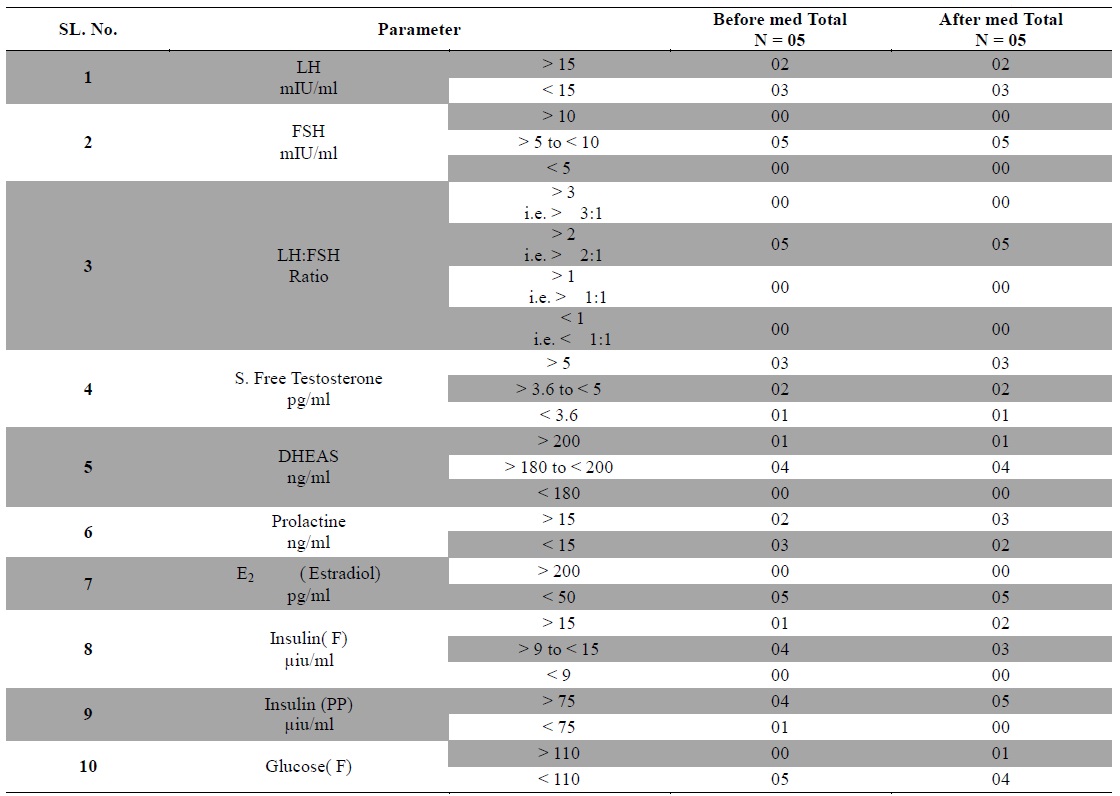
Showing data of Blood parameters recorded before and after administration of placebo (total N=05) in all patients considered together
PCOS has become an issue in India only recently when a survey revealed the incidence to be alarmingly high in women of reproductive age in Northern India (Gill et al., 2012). Since it is now known that if left untreated, PCOS can cause menstruation issues, infertility, excess hair growth, acne, and even diabetes and heart disease, more attention is now being paid on its diagnostic prediction and systematic treatment. Banaszewska et al. (2003) demonstrated that patients with PCOS tended to show elevated LH/FSH ratio (> 2) in both normo- and hyperinsulinemia. In our study, we also found that women with such elevated LH/FSH ratio were more likely to possess PCOS. Therefore this protocol can be a used as a good diagnostic feature of suspected PCOS. Similarly, results of this study also indicated that the parameters of DHEA-S can also be a potent diagnostic value in predicting PCOS of women.
No literature on scientifically conducted systematic studies on PCOS in Eastern India is so far available although CCRH (2014) has recently published a protocol for scientific studies in homeopathy on PCOS. Further, the efficacy of any homeopathic remedy bringing in beneficial effect or removing cysts totally or partially or reducing the number of cysts and volume of ovary/ovaries has not been reported in any systematically conducted scientific studies, though the use of the two homeopathic drugs, namely, Calc and Lyco, is often made in cases of suspected PCOS. In the present study, it was observed that in twenty one out of forty patients, the cysts were totally removed, 11 by Calc and 10 by Lyco. Thus both of these remedies had efficacy for eliminating cysts in about 50% cases, which is quite a significant and encouraging finding. When the statistical data of efficacy of the individual remedy was critically analyzed, it was further revealed that the administration of Calc showed statistically significant changes in respect of LH, FSH, LH/FSH ratio, DHEA-S, Estrogen, and both fasting and PP insulin, which was also the same in the Lyco administered group, only difference being in the level of significance. Therefore, both the remedies were found to have more or less similar effects on PCOS, and any of these remedies could be prescribed to patients individualized through their guiding symptoms. Since homeopathic remedies are not known to cause side-effects and produce no toxicity, these results would validate the use of these remedies in patients diagnosed with PCOS.
PCOS has been reported to be a common cause of ovarian dysfunction in women with anovulation (Lin and Wu, 2015). The main symptoms in PCOS are stated to be chronic anovulation, hyperandrogenism, and/or the presence of polycystic ovary morphology from ultrasound examination. Along with symptoms, the phenotypic manifestation of this disorder is associated with various degrees of gonadotropic and metabolic abnormalities, attributable to the interaction of multiple genetic and environmental factors. One among the various causative factors which have been implicated is the association of PCOS with Vitamin-D (Dasgupta et al., 2015); vitamin-C has a demonstrable relationship with anti-Mullerian hormone (AMH). In particular, vitamin D and calcium supplementation in addition to metformin therapy in women with PCOS has been reported to yield good result in producing beneficial effects on menstrual regularity and ovulation (Rashidi et al., 2009). Therefore, it would be interesting to see if the conjoint treatment with either Calc or Lyco with supplementation of these vitamins could induce faster and complete amelioration of PCOS, which may form the basis of some future program.
Homeopathic remedies are known to have no or negligible side-effects, and can also be used as a supportive medicine. Some patients/physicians can find the results not only more encouraging, but this would give them more confidence of using these ultra-highly diluted homeopathic remedies for removal of ovarian cysts and for amelioration of various irregularities observed in menstrual problems associated with PCOS.
The authors have no conflicting financial interests
